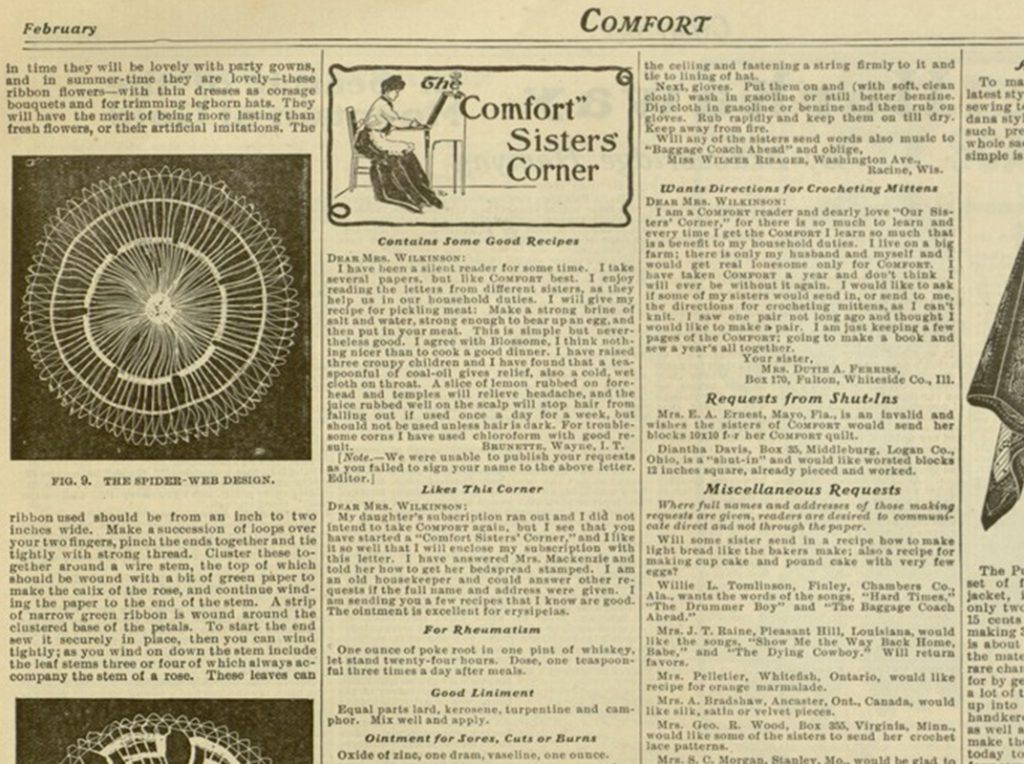 The way brands focus on the idea of “community building” in their digital marketing today, you’d think this generation invented the idea. Not so, according to Lorraine Boissoneault in The Smithsonian.
The way brands focus on the idea of “community building” in their digital marketing today, you’d think this generation invented the idea. Not so, according to Lorraine Boissoneault in The Smithsonian.
Boissoneault shares a short excerpt from the July 1907 issue of Comfort Magazine:
“Little Miss Fannie Allison Troutsmans writes that she is lonesome and would like to hear from Comfort readers,” the column begins. “She says she is the youngest of ten children of whom four only are living, and adds that her oldest brother, a conductor on the Southern Railroad, was killed by a train at Spartanburg, S.C.”
The appeal included Miss Fannie’s original words and her address in North Carolina where readers could send letters and connect.
It’s like Facebook in real time, in print. In much the same way that technology drove our current social media evolution, it did the same 100 years ago, Boissoneault explains.
“In the decades following the Civil War, rapidly advancing printing press technology and an expanding postal delivery network allowed the number of publications in the U.S. to explode,” she writes. “Whereas only 700 publications existed in 1865 (including Harper’s Weekly, Confederate Veteran and Southern Historical Society Papers), they numbered more than 3,000 by 1885, and more than 4,400 by 1890.”
On the heels of this printing technology, the USPS began experimenting with Rural Free Delivery in the 1890s. This mean that the 65% of Americans who were living outside of “urban” areas (defined as towns of 2,500 or more back then) could now get these magazines delivered directly instead of dropped off at mail-delivery points.
This was a turning point for direct mail catalogs, and circulation thrived. Of course, it wasn’t all “socializing,” as Boissoneault explains. These publications were intended to drive revenue, for the publishers and the advertisers.
“Peruse the pages of old editions of Comfort and you’ll find advertisements offering a free pocket watch for those willing to sell bluing dye for laundry, and ‘Duby’s Ozark Herbs’ to dye gray hairs without coloring the scalp, and cheap fur scarves and muffs, and medical cures like Dr. Coffee’s 80-page eye book to cure all eye diseases,” she notes.
For the readers, the editorial content provided a sense of connection to a larger world that was often out of reach. Yet they didn’t last: Technology once again made better roads, easier travel, and other forms of connection more possible in our day-to-day lives. Yet, oddly enough, it seems the Post Office itself had a lot to do with the demise of the industry.
“Many ceased publication after 1907, when the Post Office required lists of paid subscribers for magazines asking for a lower mailing rate,” Boissoneault notes. “Among the mail-order magazines that survived the culling were Woman’s World and Comfort, both of which lasted until 1940.”
We can draw so many parallels to our modern times, with people looking to connect, brands looking to sell, and a postal service that can’t seem to get out of its own way to help make that happen. The one thing that hasn’t changed – even with the massive upheavals in how we communicate – is the power of direct mail to connect.

January 30, 2018, 2:17 pm